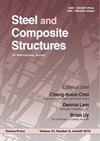压电功能梯度石墨烯微片的屈曲处理
IF 4
3区 工程技术
Q1 CONSTRUCTION & BUILDING TECHNOLOGY
引用次数: 10
摘要
微机电系统(MEMS)广泛应用于传感器、生物医学设备、光学和微加速度计等领域。碳纳米管和石墨烯薄片等新型增强材料通过改变石墨烯薄片的特性,提供了具有可控力学参数的更刚性结构。本文研究了具有两个压电层的功能梯度石墨烯微片在外加电压作用下的屈曲分析。控制方程基于基尔霍夫板理论假设,并结合修正的耦合应力理论考虑微观尺度的影响。考虑沿微板厚度的均匀温度变化和外加电场。此外,外面内机械载荷沿微板边缘均匀分布。利用哈密顿原理提取控制方程。采用Halpin-Tsai微力学模型评价了石墨烯片增强复合材料层的材料性能。在简支边界条件下,用Navier方法求解控制方程。研究了外加电压、材料长度尺度参数、压电层厚度、石墨烯片的边长、长度和重量分数以及石墨烯片的分布模式对临界屈曲温度变化和面内临界屈曲载荷的影响。结果表明,石墨烯薄片的分布模式与热屈曲强度的降低无关,而机械屈曲强度却得到了提高。此外,与石墨烯血小板分布模式无关,负电压(-50伏)增强微板抗热屈曲稳定性约9%,而正电压(50伏)降低临界屈曲载荷约9%。本文章由计算机程序翻译,如有差异,请以英文原文为准。
Buckling treatment of piezoelectric functionally graded graphene platelets micro plates
Micro-electro-mechanical systems (MEMS) are widely employed in sensors, biomedical devices, optic sectors, and micro-accelerometers. New reinforcement materials such as carbon nanotubes as well as graphene platelets provide stiffer structures with controllable mechanical specifications by changing the graphene platelet features. This paper deals with buckling analyses of functionally graded graphene platelets micro plates with two piezoelectric layers subjected to external applied voltage. Governing equations are based on Kirchhoff plate theory assumptions beside the modified couple stress theory to incorporate the micro scale influences. A uniform temperature change and external electric field are regarded along the micro plate thickness. Moreover, an external in-plane mechanical load is uniformly distributed along the micro plate edges. The Hamilton's principle is employed to extract the governing equations. The material properties of each composite layer reinforced with graphene platelets of the considered micro plate are evaluated by the Halpin–Tsai micromechanical model. The governing equations are solved by the Navier's approach for the case of simply-supported boundary condition. The effects of the external applied voltage, the material length scale parameter, the thickness of the piezoelectric layers, the side, the length and the weight fraction of the graphene platelets as well as the graphene platelets distribution pattern on the critical buckling temperature change and on the critical buckling in-plane load are investigated. The outcomes illustrate the reduction of the thermal buckling strength independent of the graphene platelets distribution pattern while meanwhile the mechanical buckling strength is promoted. Furthermore, a negative voltage, -50 Volt, strengthens the micro plate stability against the thermal buckling occurrence about 9% while a positive voltage, 50 Volt, decreases the critical buckling load about 9% independent of the graphene platelet distribution pattern.
求助全文
通过发布文献求助,成功后即可免费获取论文全文。
去求助
来源期刊

Steel and Composite Structures
工程技术-材料科学:复合
CiteScore
8.50
自引率
19.60%
发文量
0
审稿时长
7.5 months
期刊介绍:
Steel & Composite Structures, An International Journal, provides and excellent publication channel which reports the up-to-date research developments in the steel structures and steel-concrete composite structures, and FRP plated structures from the international steel community. The research results reported in this journal address all the aspects of theoretical and experimental research, including Buckling/Stability, Fatigue/Fracture, Fire Performance, Connections, Frames/Bridges, Plates/Shells, Composite Structural Components, Hybrid Structures, Fabrication/Maintenance, Design Codes, Dynamics/Vibrations, Nonferrous Metal Structures, Non-metalic plates, Analytical Methods.
The Journal specially wishes to bridge the gap between the theoretical developments and practical applications for the benefits of both academic researchers and practicing engineers. In this light, contributions from the practicing engineers are especially welcome.
 求助内容:
求助内容: 应助结果提醒方式:
应助结果提醒方式:


